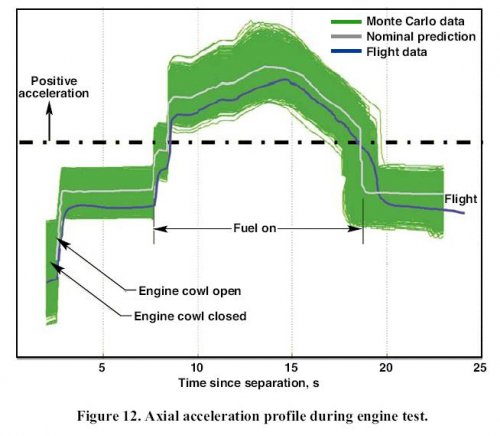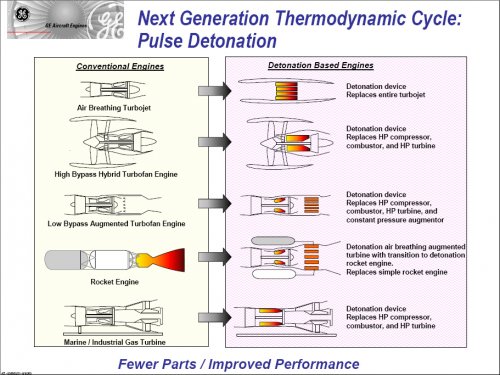I thought I saw a graph one time of an accelerometer which was a rather noisy signal around a mean almost zero which they had to average to find any evidence of net thrust.shockonlip said:Evidently the 2nd X-43A flight did some acceleration.
Pulse Detonation Wave engines (PDE)
- Thread starter blackkite
- Start date
lantinian
ACCESS: Top Secret
- Joined
- 24 March 2007
- Messages
- 539
- Reaction score
- 174
'Yes, of course you do. I am just talking about keeping the Mach 4 conditions over Mach 6. That means speed of airflow and temperature. Current methods of slowing down incoming air actually put more energy into it. You get to a point where incoming air temperature does not allow you to achieve the needed compression ration ( hot air = low pressure air). Probably other complications arise too.You mean you don't use the inlet to slow the flow down to subsonic speeds before running it through the PDE?
There was a recent cutaway drawing of Hotol spacecraft project published in Flight International Online.
http://www.secretprojects.co.uk/forum/index.php?action=dlattach;topic=277.0;attach=43106
One interesting approach they used is to cool down incoming air and make the air-breathing system usable over a larger speed spectrum. Well, at least in theory.
shockonlip
ACCESS: Top Secret
- Joined
- 29 January 2008
- Messages
- 605
- Reaction score
- 54
Simon666 said:I thought I saw a graph one time of an accelerometer which was a rather noisy signal around a mean almost zero which they had to average to find any evidence of net thrust.shockonlip said:Evidently the 2nd X-43A flight did some acceleration.
Attached is the X-43 chief engineer's Fig 12. pg.15 chart from their
AIAA paper: AIAA 2005-3332 on flight 2 (Mach 7).
The text associated with it is:
"During the time the engine was operating, the scramjet did accelerate
the vehicle and achieved performance very close to the preflight predictions.
Figure 12 shows the approximate flight axial acceleration curve as compared
to the nominal and Monte Carlo prediction data."
Attachments
shockonlip
ACCESS: Top Secret
- Joined
- 29 January 2008
- Messages
- 605
- Reaction score
- 54
quellish said:
For a hypersonic aircraft the inlet is where it all comes together, which is why on designs like the X-30 it's so dominant, yet fully integrated with the rest of the aircraft, unlike subsonic or supersonic aircraft.
I wouldn't say that on a hypersonic vehicle the inlet is where it all comes together.
There are so many parts that have to be right for the type of mission (for example:
cruise or accelerator) that it is a large optimization problem that goes beyond just
the inlet.
airrocket
Dreams To Reality
Mach 12 is max for airbreather. Beyond M12 close the inlet and go all rocket. M20 is NASP type 0 to orbit air-breather BS. M6 is about max for LACE type OX collection. Sabre/Skylon propulsion design is a good example of using ram to rocket cycles skipping the nasty SCRAM cycle.
KJ_Lesnick
ACCESS: Top Secret
- Joined
- 13 February 2008
- Messages
- 1,042
- Reaction score
- 111
If it's not suited as a rocket engine, then wouldn't you want to work in air breathing mode more?
KJ
KJ
Matej
Multiuniversal creator
Nik
ACCESS: Top Secret
- Joined
- 15 July 2009
- Messages
- 1,263
- Reaction score
- 1,057
I'm concerned that PDE & Co. will go the tip-jet helo route. Neat notion, but thirsty, noisy and prone to exasperating misfire modes. Think SR71's notorious 'un-lights' in a rotary engine...
Still, there seems a potential envelope between ramjets, rockets and eg SABRE cycle...
==
Slightly OT: I'm reminded that some aspects of eg LACE and other hypersonic propulsion inlets are euphemistically labelled 'negative drag'...

Still, there seems a potential envelope between ramjets, rockets and eg SABRE cycle...
==
Slightly OT: I'm reminded that some aspects of eg LACE and other hypersonic propulsion inlets are euphemistically labelled 'negative drag'...
- Joined
- 31 December 2006
- Messages
- 802
- Reaction score
- 362
Aerojet Rocketdyne rotating detonation engine re-purposed for natural gas power plants:
http://www.rocket.com/article/aerojet-rocketdyne-mature-rotating-detonation-engine-technology-cooperation-department
http://www.rocket.com/article/aerojet-rocketdyne-mature-rotating-detonation-engine-technology-cooperation-department
marauder2048
"I should really just relax"
- Joined
- 19 November 2013
- Messages
- 3,157
- Reaction score
- 926
George Allegrezza said:Aerojet Rocketdyne rotating detonation engine re-purposed for natural gas power plants:
http://www.rocket.com/article/aerojet-rocketdyne-mature-rotating-detonation-engine-technology-cooperation-department
Intriguing given recent AFRL sponsored work into using LNG as an aviation fuel/heat sink/power source for next generation fighters.
https://www.researchgate.net/profile/Rory_Roberts/publication/280925005_Liquefied_Natural_Gas_as_the_Next_Aviation_Fuel/links/55cc8e7b08aebc967dfe2b69.pdf
marauder2048
"I should really just relax"
- Joined
- 19 November 2013
- Messages
- 3,157
- Reaction score
- 926
George Allegrezza said:A parallel RDE effort for DOD aerospace applications is mentioned in the AR release.
Thanks for pointing that out.
- Joined
- 21 January 2015
- Messages
- 12,074
- Reaction score
- 16,134
Aerojet Rocketdyne Explores Detonation Engine Options
http://m.aviationweek.com/technology/aerojet-rocketdyne-explores-detonation-engine-options
For over 70 years, jet engines have powered airplanes ever more safely and efficiently. But, despite higher core temperatures and pressures, and the introduction of efficient propulsion concepts like the geared fan, conventional gas turbines may be running out of runway. A fundamental change in the way a gas turbine combusts air and fuel in its core could open a path to a new era of jet engine development, however. Long pursued by propulsion researchers as a potential game-changing ...
http://m.aviationweek.com/technology/aerojet-rocketdyne-explores-detonation-engine-options
Australia and Germany successfully tested an RDE:

Pudsey said a major challenge to overcome was keeping the engine from overheating, while the next step of the project involved looking at a fully 3-D-printed, actively cooled version of the successful prototype.
Other challenges, including advanced modeling of the engine's behavior and integration of the engine into a functioning flight vehicle, remain to be overcome before proceeding to test flights.

Successful engine test brings Australian space launch capability a step closer
An Australian research consortium has successfully tested a next generation propulsion system that could enable high-speed flight and space launch services.
phys.org
- Joined
- 9 October 2009
- Messages
- 21,909
- Reaction score
- 13,481
View: https://www.youtube.com/watch?v=UwWIb3a4sSA

Tech Planet
171K subscribers
SUBSCRIBE
There are tons of weird and unconventional designs coming out. So let's look at some of the newest aerospace engines! Sources & Credits: 7. Jetopetra http://www.jetoptera.com/products/ 6. Electric Jet Engine https://spectrum.ieee.org/energywise/... https://asiatimes.com/2020/05/chinese... 5, Monarch 5 https://www.aerospacemanufacturingand... https://www.youtube.com/watch?v=anmcH... 4. Tempest Engine https://www.rolls-royce.com/products-... https://www.youtube.com/watch?v=xi8YV... 3. Fenris Air Rocket Engine https://arstechnica.com/science/2020/... https://www.facebook.com/MountainAero... 2. Pulse Detonation https://www.youtube.com/watch?v=1xVz1... (UC Detlab) https://www.youtube.com/watch?v=Joh3M... https://www.hindawi.com/journals/jc/2... https://www.ruaviation.com/news/2016/... 1. Rotating Detonation https://www.youtube.com/watch?v=i0yS-... https://www.youtube.com/watch?v=HRXVk... https://www.intechopen.com/online-fir... https://newatlas.com/space/rotating-d...
Nik
ACCESS: Top Secret
- Joined
- 15 July 2009
- Messages
- 1,263
- Reaction score
- 1,057
The RDE: Must wonder if there's some way to stabilise it by cross-linking, analogy with 'strapping' a cavity magnetron...
Perhaps 'resonance pots', per Acoustic jars ??

 en.wikipedia.org
en.wikipedia.org
Perhaps 'resonance pots', per Acoustic jars ??
Acoustic jar - Wikipedia
shin_getter
ACCESS: Top Secret
- Joined
- 1 June 2019
- Messages
- 1,092
- Reaction score
- 1,467

Japan successfully tests rocket engine propelled by shock waves
The new technology could reduce engine sizes to about one-tenth the size of ones currently used on deep space spacecraft and would be able to operate for extended periods of time.

aonestudio
I really should change my personal text
- Joined
- 11 March 2018
- Messages
- 2,962
- Reaction score
- 7,470
Would this lend itself to autophage rockets-each grain deposited in such a way that each pulse eats a little more as part of a hybid system-the LOX and tech on a reusable upper stage. The inert all fuel lower stages being good shock absorbers?
aonestudio
I really should change my personal text
- Joined
- 11 March 2018
- Messages
- 2,962
- Reaction score
- 7,470

DARPA’S NEW MISSILE HINTS AT TRULY GAME-CHANGING TECHNOLOGY
Last week, the Defense Advanced Research Projects Agency (DARPA) quietly unveiled a new high-speed missile program called Gambit. The program is meant to leverage a novel method of propulsion that could have far-reaching implications not just in terms of weapons development, but for high-speed...
 www.sandboxx.us
www.sandboxx.us
- Joined
- 21 January 2015
- Messages
- 12,074
- Reaction score
- 16,134
NASA's Advanced Rotating Detonation Variant Additive Rocket Chamber (ARDVARC-ACO) program is edging up to TRL 4
There is a short clip of it running in this video at about 1:47
aonestudio
I really should change my personal text
- Joined
- 11 March 2018
- Messages
- 2,962
- Reaction score
- 7,470

Rotating detonation engines at the forefront of pressure gain combustion
The Pressure Gain Combustion Technical Committee advances the investigation, development and application of pressure gain technologies for improving propulsion and power generation systems and achieving new mission capabilities.
Nik
ACCESS: Top Secret
- Joined
- 15 July 2009
- Messages
- 1,263
- Reaction score
- 1,057
I still think they need to 'cross-tie' RDE so becomes predictably cyclical...
IIRC, the Germans had toyed with magnetron concept but, unable to 'stabilise' the modes or frequency, discarded it. Apparently they were flabbergasted when they saw how a recovered RAF widget solved both problems: Modes by cross-linking, so did a sorta 'waltz' instead of just jitter-bugging, and frequency by designing associated transceiver with enough band-width to use what was generated instead of trying to constrain it...
IIRC, the Germans had toyed with magnetron concept but, unable to 'stabilise' the modes or frequency, discarded it. Apparently they were flabbergasted when they saw how a recovered RAF widget solved both problems: Modes by cross-linking, so did a sorta 'waltz' instead of just jitter-bugging, and frequency by designing associated transceiver with enough band-width to use what was generated instead of trying to constrain it...
aonestudio
I really should change my personal text
- Joined
- 11 March 2018
- Messages
- 2,962
- Reaction score
- 7,470
New rocket engine design, who’s this?#NASAMarshall propulsion engineers designed the Rotating Detonation Rocket Engine (RDRE) that may one day power both human landers and interplanetary vehicles to deep space destinations!
— NASA Marshall (@NASA_Marshall) January 25, 2023
MORE: https://t.co/VP9gEuJlYp pic.twitter.com/YVSRDWzz6n

NASA Validates Revolutionary Propulsion Design for Deep Space Missions
The high-performance propulsion system of the rotating detonation rocket engine has the potential to power both human landers and interplanetary vehicles to deep space destinations, such as the Moon and Mars.
- Joined
- 4 July 2010
- Messages
- 2,509
- Reaction score
- 3,073
SSME is very efficient for what it is, but there's so much more potential out there.
View: https://twitter.com/DrChrisCombs/status/1293172198484643840?t=3toRnjbfzy6tfxHiDfp2FQ&s=19
So the top-line big number is the potential 25% theoretical efficiency improvement from pulsed & rotating detonation engine concepts (PDEs & RDEs, respectively) & ISP > 8000s for hydrogen fuel up to hypersonic Mach numbers, far exceeding other air-breathing and rocket engines 2/n pic.twitter.com/PUrHe2DPSw
— Chris Combs (iterative design enjoyer) (@DrChrisCombs) August 11, 2020
Dagger
ACCESS: Secret
- Joined
- 24 December 2019
- Messages
- 334
- Reaction score
- 620
I agree with sferrin.
I don't see which laws of thermodynamics or any other laws of physics can be circumnavigated by "rotating detonation" in a rocket engine.
That NASA RDRE rocket engine test at Marshall mentions 622 psi which is only 42 bar. They don't mention actual achieved ISP so that already says enough.
Chris Combs (who is that guy?) seems to be talking about air breathing engines, not rocket engines.
EDIT: in the mean time I found out that Chris Combs is an assisting professor at University of Texas San Antonio.
When I see somebody presenting himself with laser eyes I lose all respect:

I don't see which laws of thermodynamics or any other laws of physics can be circumnavigated by "rotating detonation" in a rocket engine.
That NASA RDRE rocket engine test at Marshall mentions 622 psi which is only 42 bar. They don't mention actual achieved ISP so that already says enough.
Chris Combs (who is that guy?) seems to be talking about air breathing engines, not rocket engines.
EDIT: in the mean time I found out that Chris Combs is an assisting professor at University of Texas San Antonio.
When I see somebody presenting himself with laser eyes I lose all respect:

Last edited:
- Joined
- 21 April 2009
- Messages
- 13,718
- Reaction score
- 7,593

NASA just test fired a rocket designed to power long-term Moon trips
NASA's new RDRE advanced rocket has just been successfully test fired at its Marshall Space Flight Center in Huntsville in Alabama.
- Joined
- 15 January 2021
- Messages
- 392
- Reaction score
- 1,429
In any heat machine, the efficiency is determined by delta temperature and delta pressure. The higher temperature and pressure that can be achieved in the working fluid when heat is added, the higher the efficiency. In air breathing engines, the pressure is limited by the capability of the fan and compressor. With a rotating detonation combustor, the supersonic detonation wave raises the pressure and temperature significantly higher than than the inlet pressure while shielding the compressor from that elevated pressure, greatly increasing the efficiency of the thermal cycle.
For a liquid fueled rocket engine, the fuel and oxidizer pumps have to deliver their liquids to the combustion chamber at higher pressures than the chamber pressure. Pressurizing liquid flow is much easier than than compressing air, but it is still a challenge. Rotating detonation combustion can once again raise the combustion pressure higher than the pump pressure, but it would not seem to be as much of an ISP advantage as for an air breathing engine.
For a liquid fueled rocket engine, the fuel and oxidizer pumps have to deliver their liquids to the combustion chamber at higher pressures than the chamber pressure. Pressurizing liquid flow is much easier than than compressing air, but it is still a challenge. Rotating detonation combustion can once again raise the combustion pressure higher than the pump pressure, but it would not seem to be as much of an ISP advantage as for an air breathing engine.
- Joined
- 3 June 2011
- Messages
- 18,307
- Reaction score
- 12,088
That's the explanation I was looking for.In any heat machine, the efficiency is determined by delta temperature and delta pressure. The higher temperature and pressure that can be achieved in the working fluid when heat is added, the higher the efficiency. In air breathing engines, the pressure is limited by the capability of the fan and compressor. With a rotating detonation combustor, the supersonic detonation wave raises the pressure and temperature significantly higher than than the inlet pressure while shielding the compressor from that elevated pressure, greatly increasing the efficiency of the thermal cycle.
For a liquid fueled rocket engine, the fuel and oxidizer pumps have to deliver their liquids to the combustion chamber at higher pressures than the chamber pressure. Pressurizing liquid flow is much easier than than compressing air, but it is still a challenge. Rotating detonation combustion can once again raise the combustion pressure higher than the pump pressure, but it would not seem to be as much of an ISP advantage as for an air breathing engine.
One question though. "significantly higher than than the inlet pressure while shielding the compressor from that elevated pressure" How does it do that? Shield the compressor that is?
Last edited:
- Joined
- 15 January 2021
- Messages
- 392
- Reaction score
- 1,429
With the Space Shuttle engines, they ran very high chamber pressures for high ISP. Their high pressure LH and LOX pumps were very troublesome over the years until NASA went to P&W for their expertise and replaced the original Rocketdyne pumps.
RDE may be a big advantage for smaller rocket engines that can't afford the weight and complication of high pressure turbopumps.
The other thing I noted was the use of a plug nozzle on the RDE rocket demonstrator. Plug nozzles have virtually unlimited variation in expansion ratios with no moving parts, while the conventional bell shaped convergent / divergent nozzle is either optimized for low altitude expansion into atmospheric pressure (i.e. a short divergent section), or into vacuum (a long divergent section). Some RL10 engines had an outer carbon fiber skirt that could be translated aft to make the divergent bell longer as the rocket extended. The plug nozzle, with the inner flow path defined by the plug, can readily adjust its supersonic expansion using the surrounding decreasing pressure ambient air to passively control the expansion ratio.
RDE may be a big advantage for smaller rocket engines that can't afford the weight and complication of high pressure turbopumps.
The other thing I noted was the use of a plug nozzle on the RDE rocket demonstrator. Plug nozzles have virtually unlimited variation in expansion ratios with no moving parts, while the conventional bell shaped convergent / divergent nozzle is either optimized for low altitude expansion into atmospheric pressure (i.e. a short divergent section), or into vacuum (a long divergent section). Some RL10 engines had an outer carbon fiber skirt that could be translated aft to make the divergent bell longer as the rocket extended. The plug nozzle, with the inner flow path defined by the plug, can readily adjust its supersonic expansion using the surrounding decreasing pressure ambient air to passively control the expansion ratio.
Ok so I downloaded one tech report about it (will attach it later).
That thing has potential to improve "classic" specific impulses by 10% average.
And thus, behold... (page 7 of the pdf, now attached)
-H202/ kerosene: 330 seconds plus 10% = 360 seconds
-Kerolox: 360 seconds - up to 400
-Methalox: from 375 to way above 400, 420 something.
-And hydrolox is even more startling: from the usual 460 to way, way above 500. Exactly what is needed to make SSTO happens with slightly less insane propellant mass fraction than 0.88 (with zero payload) or 0.90 and above (small payload).
And since that engine is high thrust, hence not an electric thruster with minuscule thrust...
That thing has potential to improve "classic" specific impulses by 10% average.
And thus, behold... (page 7 of the pdf, now attached)
-H202/ kerosene: 330 seconds plus 10% = 360 seconds
-Kerolox: 360 seconds - up to 400
-Methalox: from 375 to way above 400, 420 something.
-And hydrolox is even more startling: from the usual 460 to way, way above 500. Exactly what is needed to make SSTO happens with slightly less insane propellant mass fraction than 0.88 (with zero payload) or 0.90 and above (small payload).
And since that engine is high thrust, hence not an electric thruster with minuscule thrust...
Attachments
Last edited:
Would this tech best work for expendables? When I hear 'pulse' I remember the Titan II nozzle sawing incident. Hypergolics might be best for this-bleed a little of each in the other's tank....and hope the tanks empty 'afore something cracks? Titan II was near SSTO territory anyway-maybe this could push it over the line as it were. Martin Astrorocket more do-able now? A spaceplane with mass produced single use engines? Flip the script on Vulcan...keep the core-burn up the motor.
Last edited:
- Joined
- 3 June 2011
- Messages
- 18,307
- Reaction score
- 12,088
Plug nozzles have been around forever but the problem has always been keeping them cool. Non-afterburning turbojets tend to have them (the core section of high bypass engines, and older turbojets) but rockets have been rare.With the Space Shuttle engines, they ran very high chamber pressures for high ISP. Their high pressure LH and LOX pumps were very troublesome over the years until NASA went to P&W for their expertise and replaced the original Rocketdyne pumps.
RDE may be a big advantage for smaller rocket engines that can't afford the weight and complication of high pressure turbopumps.
The other thing I noted was the use of a plug nozzle on the RDE rocket demonstrator. Plug nozzles have virtually unlimited variation in expansion ratios with no moving parts, while the conventional bell shaped convergent / divergent nozzle is either optimized for low altitude expansion into atmospheric pressure (i.e. a short divergent section), or into vacuum (a long divergent section). Some RL10 engines had an outer carbon fiber skirt that could be translated aft to make the divergent bell longer as the rocket extended. The plug nozzle, with the inner flow path defined by the plug, can readily adjust its supersonic expansion using the surrounding decreasing pressure ambient air to passively control the expansion ratio.
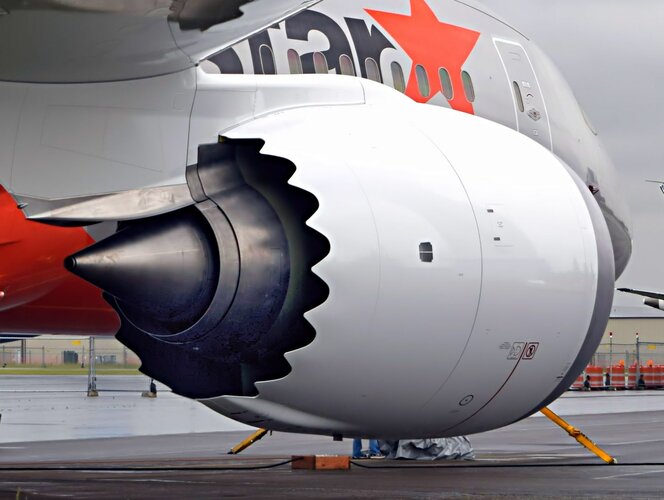
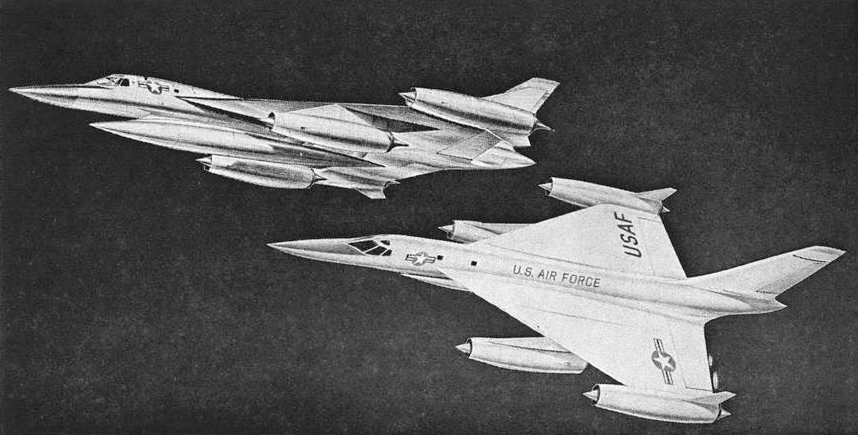
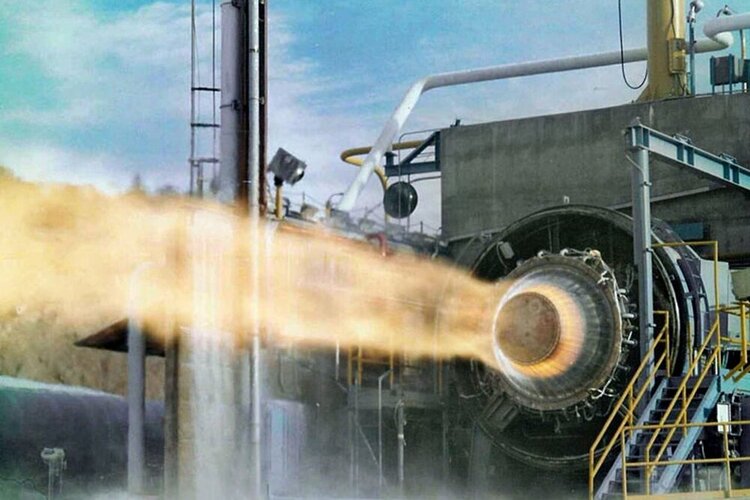
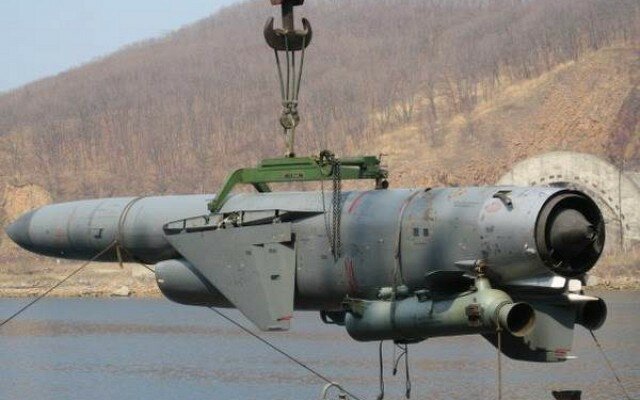
- Joined
- 15 January 2021
- Messages
- 392
- Reaction score
- 1,429
The high bypass engine pictured has a center tailcone, but I think this is more of a flow director as part of the core flow / fan flow integration, since the exhaust flow is unlikely to be supersonic.
The Hound Dog missile with the J52 turbojet definitely had a plug nozzle since the nozzle pressure ratio was high enough for supersonic expansion and the flight envelope was fast enough to need the self adjusting nature of this design, But, as you noted, not afterburning.
The National Aerospace Plane SSTO designs showed a 2D plug nozzle in their Linear Aerospike concept.
The Hound Dog missile with the J52 turbojet definitely had a plug nozzle since the nozzle pressure ratio was high enough for supersonic expansion and the flight envelope was fast enough to need the self adjusting nature of this design, But, as you noted, not afterburning.
The National Aerospace Plane SSTO designs showed a 2D plug nozzle in their Linear Aerospike concept.
- Joined
- 15 January 2021
- Messages
- 392
- Reaction score
- 1,429
The detonation shock wave compresses the gas in front of it, so the gas being fed in by the pump (liquid) or compressor (air) behind the supersonic shock wave doesn’t feel that pressure increase.That's the explanation I was looking for.In any heat machine, the efficiency is determined by delta temperature and delta pressure. The higher temperature and pressure that can be achieved in the working fluid when heat is added, the higher the efficiency. In air breathing engines, the pressure is limited by the capability of the fan and compressor. With a rotating detonation combustor, the supersonic detonation wave raises the pressure and temperature significantly higher than than the inlet pressure while shielding the compressor from that elevated pressure, greatly increasing the efficiency of the thermal cycle.
For a liquid fueled rocket engine, the fuel and oxidizer pumps have to deliver their liquids to the combustion chamber at higher pressures than the chamber pressure. Pressurizing liquid flow is much easier than than compressing air, but it is still a challenge. Rotating detonation combustion can once again raise the combustion pressure higher than the pump pressure, but it would not seem to be as much of an ISP advantage as for an air breathing engine.
One question though. "significantly higher than than the inlet pressure while shielding the compressor from that elevated pressure" How does it do that? Shield the compressor that is?
Similar threads
-
-
-
-
Engineering Division GL- series (1920s aerial target gliders)
- Started by Jos Heyman
- Replies: 10
-

